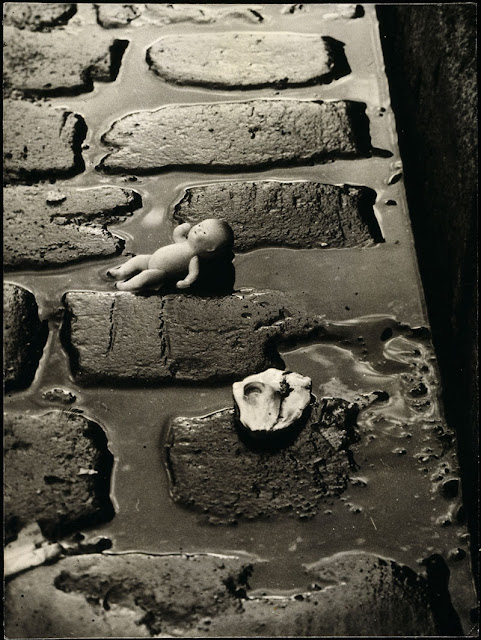German painter, draughtsman, photographer and illustrator.
In 1932 Wols travelled to Frankfurt am Main to study anthropology. He then moved to Berlin and entered the Bauhaus, recently transferred from Dessau. After only a few weeks Moholy-Nagy advised him to move to Paris. He soon met many artists associated with the Surrealist movement. Wols spent the remainder of 1932 in Paris, producing his first paintings but also working as a photographer.
At the outbreak of World War II Wols was interned for 14 months. During this period he concentrated on ink drawings of the sort he had been producing since 1932.
In 1932 Wols travelled to Frankfurt am Main to study anthropology. He then moved to Berlin and entered the Bauhaus, recently transferred from Dessau. After only a few weeks Moholy-Nagy advised him to move to Paris. He soon met many artists associated with the Surrealist movement. Wols spent the remainder of 1932 in Paris, producing his first paintings but also working as a photographer.
At the outbreak of World War II Wols was interned for 14 months. During this period he concentrated on ink drawings of the sort he had been producing since 1932.
He started to paint in oils in 1946. This new development in his art proved enormously influential, earning him the praise of artists such as Mathieu and critics such as Michel Tapié, who coined the term Art autre to describe their post-war work.
In 1947 Wols fell ill but lacked the money to go to hospital, and throughout 1948 he worked largely in bed. In the last few years of his life he continued to produce fantastic ink and wash drawings. Undergoing treatment for alcoholism, he moved to the country at Champigny-sur-Marne, south-east of Paris, in June 1951. His early death later that year from food poisoning helped foster the legendary reputation that grew up around him soon afterwards. His paintings helped pioneer Art informel and Tachism. Influenced by the writings of the Chinese Daoist philosopher Laozi, Wols also wrote poems and aphorisms that expressed his aesthetic and philosophical ideas.(tate.org.uk)
In 1947 Wols fell ill but lacked the money to go to hospital, and throughout 1948 he worked largely in bed. In the last few years of his life he continued to produce fantastic ink and wash drawings. Undergoing treatment for alcoholism, he moved to the country at Champigny-sur-Marne, south-east of Paris, in June 1951. His early death later that year from food poisoning helped foster the legendary reputation that grew up around him soon afterwards. His paintings helped pioneer Art informel and Tachism. Influenced by the writings of the Chinese Daoist philosopher Laozi, Wols also wrote poems and aphorisms that expressed his aesthetic and philosophical ideas.(tate.org.uk)
Wols' painting style, as early as 1946-47 (Untitled, 1946–47, Yellow Composition, 1946–7; Berlin, Neue N.G., It's All Over The City, 1947), was informal, gestural, with the paint applied in layers by means of dripping and with scratching into the surface. This new development in art proved influential, earning him the praise of artists such as Georges Mathieu and critics such as Michel Tapié, who coined the term Art autre (the Other Art) to describe the new style.
Wols was noted for his etchings and for his use of stains (taches) of color dabbed onto the canvas (as exemplified by his painting Composition, c. 1950). His painted work contains figurative elements as well as free improvisations and abstract elements. Spontaneity and immediateness determine the creative work of Wols, who never underwent any formal artistic training. Randomness (initially inspired by the Surrealist psychic Automatism) plays an important role in his unstructured compositions. In later years Wols was particularly interested in the combination of powerful brushstrokes with a relief-like painted surface structure.Wikipedia
Wols was noted for his etchings and for his use of stains (taches) of color dabbed onto the canvas (as exemplified by his painting Composition, c. 1950). His painted work contains figurative elements as well as free improvisations and abstract elements. Spontaneity and immediateness determine the creative work of Wols, who never underwent any formal artistic training. Randomness (initially inspired by the Surrealist psychic Automatism) plays an important role in his unstructured compositions. In later years Wols was particularly interested in the combination of powerful brushstrokes with a relief-like painted surface structure.Wikipedia








No comments:
Post a Comment